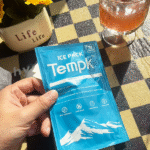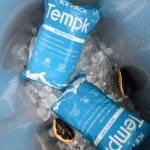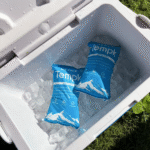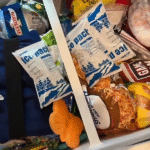O envio rápido e seguro de mercadorias sensíveis à temperatura pode ser assustador, especialmente quando você precisa deles congelados na chegada. Pacote de gelo seco no mesmo dia O transporte de folhas oferece uma solução prática ao combinar o frio extremo do gelo seco com a versatilidade das folhas de gelo. O gelo seco atinge -109,3°F (-78,5 ° C.) e sublima em gás sem deixar líquido para trás, tornando-o um refrigerante ideal para alimentos congelados, amostras biológicas e vacinas. No entanto, embalagem inadequada ou erros de cálculo podem causar deterioração ou riscos à segurança. Este guia completo responde às suas perguntas urgentes, detalha as melhores práticas e cobre as mais recentes inovações da cadeia de frio para ajudá-lo a dominar o envio de folhas de gelo seco no mesmo dia.
Como o envio de folhas de gelo seco no mesmo dia mantém as mercadorias congeladas e por que isso é importante para remessas perecíveis
Taxas de sublimação de gelo seco e quantidades recomendadas para vários comprimentos de remessa
Selecionando e preparando folhas de gelo seco – hidratação, congelamento e colocação dentro de recipientes
Materiais de embalagem e isolamento necessário para otimizar o desempenho do gelo seco
Requisitos regulatórios e de segurança como ventilação, rotulagem e limites de peso
Comparando folhas de gelo seco com gel ou compressas frias, incluindo faixas de temperatura e considerações de custo
Tendências emergentes em 2025 – Rastreamento de IoT, Logística orientada por IA e materiais sustentáveis
Por que o envio da folha de gelo seco no mesmo dia é tão importante?
O envio no mesmo dia protege produtos altamente perecíveis, minimizando o tempo fora de ambientes com temperatura controlada. Itens como frutos do mar, carnes congeladas, vacinas e amostras biológicas podem degradar-se rapidamente se expostas mesmo a breves variações de temperatura. O gelo seco fornece temperaturas extremamente baixas (≈−109°F) e sublima a uma taxa de 5–10 libras cada 24 horas em um recipiente isolado, tornando-o ideal para remessas que devem permanecer congeladas, mas não justificam custos de carga aérea noturna. Adicionar folhas de embalagem ao redor dos produtos ajuda a distribuir o frio uniformemente e almofada itens delicados. Para remetentes, usar essas folhas com entrega no mesmo dia reduz a deterioração, atende aos padrões regulatórios e aumenta a satisfação do cliente.
Como uma folha de gelo seco mantém os produtos congelados?
O gelo seco é dióxido de carbono sólido que sublima diretamente em gás, não produzindo nenhum líquido e evitando danos causados pela água. Quando combinado com folhas de embalagem – uma rede de células individuais hidratadas e congeladas antecipadamente – o frio é distribuído de maneira mais uniforme em torno de sua carga útil. O gelo seco reduz a temperatura rapidamente, enquanto a folha de embalagem atua como um amortecedor térmico, preenchendo espaços vazios e mantendo contato com o produto. As folhas da embalagem normalmente são embebidas em água por alguns minutos, deixado hidratar até cerca de ¾ polegada de espessura, então congelado sólido. Uma vez congelado, eles podem ser organizados em cima, parte inferior e laterais de seus produtos. O gás dióxido de carbono produzido durante a sublimação deve ser capaz de escapar para evitar o aumento de pressão e potencial ruptura, então a ventilação adequada é vital.
Taxa de sublimação de gelo seco e cálculo de quantidade
A sublimação de gelo seco depende da quantidade, isolamento e condições ambientais. As regras gerais incluem:
Use 5–10 libras (2.3–4,5 kg) de gelo seco por período de 24 horas para itens com peso de até 12,5 libras. Refrigeradores pequenos para um único dia geralmente precisam 5–10 libras para manter o conteúdo congelado.
Para remessas mais longas, 15–30 libras pode ser necessário para transporte de três dias. Uma proporção de meio quilo de gelo seco por quilo de produto ajuda a manter temperaturas congeladas por até 48 horas; 1.5× peso do produto estende o resfriamento para 72 horas.
A sublimação acelera em ambientes quentes ou de baixa pressão como porões de carga de avião. Ventilar o recipiente e preencher espaços vazios com materiais de embalagem diminui a taxa.
| Peso do item | 12hora de envio (topo de gelo seco) | 24–48 horas | 48–72 horas | Significado prático |
| 5 produto em libras | 3 libras de gelo seco | 5 libras | 10 libras | Amostras leves de alimentos ou biotecnologia – mínimo de gelo seco para entrega no mesmo dia |
| 10 produto em libras | 5 libras | 10 libras | 15 libras | Pacotes médios, como carnes congeladas – peso igual de gelo seco garante proteção por 48 horas |
| 20 produto em libras | 10 libras | 20 libras | 30 libras | Remessas em massa (kits de refeições) – planeje mais gelo seco e isolamento |
| 30 produto em libras | 10 lbs topo de gelo seco / 5 libras inferior | 20 libras superiores / 10 libras inferior | 30 libras superiores / 15 libras inferior | Refrigeradores grandes – camadas de gelo seco garantem um resfriamento uniforme |
Preparando folhas de gelo seco
Hidratação: Corte as folhas no tamanho desejado ao longo das costuras. Mergulhe-os em água por 1–5 minutos até atingirem cerca de ¾ polegada de espessura. Evite encharcar demais para evitar que a folha se rache.
Congelando: Coloque as folhas hidratadas no freezer até ficarem completamente sólidas. Para melhores resultados, congelar por 6–24 horas dependendo da espessura.
Colocação: Organize as folhas congeladas dentro do recipiente; coloque uma folha na parte inferior, coloque seus produtos em camadas, em seguida, adicione folhas nas laterais e na parte superior. Deixe espaço para o gás escapar.
Reutilizar: As folhas da embalagem são reutilizáveis – após o descongelamento, recongelar para remessas adicionais ou microondas (quando descongelado) para aplicações de embalagem quente.
Selecionando a embalagem certa para envio de gelo seco no mesmo dia
Tipos de isolamento e contêineres
Recipientes isolados são essenciais para retardar a sublimação e manter uma temperatura estável. Os EUA. O Departamento de Transportes e a Associação Internacional de Transporte Aéreo exigem que o contêiner seja isolado, capaz de liberar gás e construído para suportar o manuseio típico. Poliestireno expandido (EPS) caixas de espuma são comuns porque são leves e retêm bem o frio. EPS de maior densidade retarda melhor a sublimação do que a espuma de baixa densidade.
Dicas adicionais de embalagem:
Sacos selados a vácuo: Use sacos selados a vácuo ou hermeticamente fechados para evitar o contato direto entre seus produtos e gelo seco.
Forros térmicos: Forros de espuma ou isolamento a vácuo adicionam proteção extra e retardam a transferência de calor externo.
Camadas: Separe seus produtos do gelo seco embalando-os em camadas. Isso evita danos por congelamento e melhora o controle de temperatura.
Preencha o espaço vazio: Preencha os espaços vazios com papel amassado ou amendoim para minimizar o volume de ar e retardar a sublimação.
Escolhendo embalagens para diferentes cenários de remessa
| Material de embalagem | Propriedades | Quando usar | Benefício prático |
| Caixas de espuma EPS | Alto isolamento; leve | Remessas de longa distância que precisam de 24 a 72 horas de temperatura congelada | Retarda a sublimação do gelo seco e protege o conteúdo |
| Sacos selados a vácuo | Barreira hermética; flexível | Produtos pequenos ou delicados; evita contato direto | Mantém as mercadorias secas e separadas do gelo seco |
| Forros térmicos | Folha ou espuma reflexiva; cabe dentro de caixas de papelão | Remessas econômicas que precisam de isolamento moderado | Reduz a transferência de calor e umidade |
| Folhas de gelo | Células poliméricas hidratadas; reutilizável | Suplemento de gelo seco; preencher lacunas em torno dos produtos | Fornece resfriamento e amortecimento uniformes |
Requisitos de segurança e regulamentares
Segurança no manuseio e armazenamento
O gelo seco é extremamente frio e sublima em gás dióxido de carbono. Luvas de proteção, óculos de proteção e áreas ventiladas são necessários ao manusear gelo seco. As principais precauções incluem:
Ventilação: Nunca guarde gelo seco em recipientes herméticos. O gás dióxido de carbono se acumula e pode causar a explosão do recipiente. Use recipientes com orifícios de ventilação ou tampas de espuma.
Evite espaços confinados: Armazenar gelo seco em salas sem ventilação pode criar deficiência de oxigênio. Se sentir tonturas ou falta de ar, saia da área imediatamente.
Proteja superfícies: Não coloque gelo seco diretamente em bancadas ou superfícies de azulejos; o frio extremo pode causar rachaduras.
Etiqueta claramente: Marque os pacotes com “Gelo seco” ou “Dióxido de carbono sólido,”incluem o E 1845 rótulo de perigo e peso líquido de gelo seco.
Limites de peso: Remessas terrestres contendo mais de 5.5 libras (2.5 kg) de gelo seco não medicinal exigem um acordo sobre materiais perigosos. As remessas aéreas não devem exceder 200 kg.
Orientação Regulatória para Remessa
Conformidade com DOT e IATA: O gelo seco é regulamentado como um material perigoso. Os remetentes devem seguir instruções específicas de embalagem (PI904) e requisitos de treinamento.
Políticas da transportadora: A UPS recomenda adicionar gelo seco extra por um período adicional 24 horas para cobrir possíveis atrasos e insiste em recipientes de EPS devidamente ventilados. FedEx aconselha o uso de fibra, caixas de plástico ou madeira e desencoraja tambores de aço ou sacos plásticos selados.
Comparando folhas de gelo seco com gel e compressas frias
Tanto o gelo seco quanto o gel/bolsas frias servem como refrigerantes, mas eles funcionam de maneira diferente.
Temperatura e duração
Gelo seco: Mantém temperaturas em torno de -109°F e dura mais-sublimando em cerca de 10 libras por 24 horas em recipientes isolados. Não deixa resíduos líquidos e é ideal para remessas que requerem estado congelado.
Gel/ compressas frias: Normalmente mantenha o conteúdo em 35–45°F, comparável às temperaturas do refrigerador. Os pacotes de gel derretem em seis horas se não forem complementados com gelo adicional.
Custo e Segurança
Gelo seco: Mais caro e perecível. Requer equipamento de proteção e conformidade com regulamentos de materiais perigosos.
Pacotes de gel: Barato, reutilizável e mais fácil de manusear. Eles são melhores para remessas resfriadas, não congeladas, e tempos de trânsito curtos.
Aplicações Práticas
Use gelo seco para: Carnes congeladas, sorvete, amostras de diagnóstico, remessas de longa distância (sobre 48 horas).
Use pacotes de gel para: Produção fresca, produtos farmacêuticos que requerem armazenamento entre 2 e 8°C, entregas de curta distância e mercadorias que não devem congelar.
Combinando pacotes de gelo seco e gel
As compressas frias podem prolongar a vida útil do gelo seco, absorvendo primeiro o calor e retardando a sublimação. Para remessas que exigem zonas congeladas e resfriadas, combinar gelo seco (para a porção congelada) com pacotes de gel (para evitar o resfriamento excessivo de outros itens).
Otimizando a eficiência do envio no mesmo dia e minimizando a deterioração
Melhores práticas de embalagem
Pré-resfrie tudo: Pré-resfrie seus produtos e recipientes antes de embalar; itens pré-congelados requerem menos gelo seco.
Use isolamento adequado: Escolha recipientes de espuma de alta densidade e adicione revestimentos térmicos para manter a temperatura por mais tempo.
Preencha o espaço vazio: Use amendoins de embalagem ou papel amassado para reduzir o volume de ar e retardar a sublimação do gelo seco.
Monitorar temperatura: Use sensores ou registradores de dados habilitados para IoT para monitorar a temperatura durante o trânsito e alertar os transportadores se os limites forem violados.
Embalagem segura: Certifique-se de que o recipiente esteja bem vedado, mas permita a ventilação do gás. Rotule claramente e cumpra os limites de peso.
Selecionando um provedor confiável
Escolha empresas de logística com experiência em transporte de gelo seco e que ofereçam entrega no mesmo dia e rastreamento de temperatura em tempo real. Pergunte sobre a conformidade com os regulamentos DOT e IATA e confirme se usam recipientes isolados e sacos selados a vácuo. Um parceiro confiável também planejará gelo extra seco para cobrir atrasos inesperados.
Estudo de caso: Remessa bem-sucedida no mesmo dia
Exemplo: Uma empresa de biotecnologia precisava enviar 10 libras de amostras congeladas de Los Angeles para uma instalação próxima 12 horas. Pré-congelando amostras e usando 5 libras de gelo seco na parte superior e uma folha de embalagem hidratada na parte inferior, junto com sacos selados a vácuo e um recipiente EPS, a remessa chegou ainda congelada. Um sensor de temperatura registrou uma temperatura interna de -20°F durante o trânsito, e nenhum gelo seco permaneceu na chegada. Esta embalagem eficiente minimizou o desperdício e atendeu aos regulamentos do DOT.
2025 Tendências e Inovações em Logística da Cadeia de Frio
A indústria da cadeia de frio está evoluindo rapidamente, e ficar à frente das tendências garante que suas práticas de envio permaneçam eficientes e em conformidade.
Visão geral das tendências
- Automação e Robótica:A escassez de mão-de-obra e a necessidade de eficiência estão a impulsionar sistemas automatizados de armazenamento e recuperação (AS/RS)e manuseio robótico em armazéns. Os robôs reduzem erros e melhoram o rendimento, aumentando a confiabilidade do transporte com temperatura controlada.
- Sustentabilidade como valor fundamental:As regulamentações ambientais e a procura dos consumidores estão a pressionar as empresas a adoptar sistemas de refrigeração energeticamente eficientese sustentável, materiais de embalagem recicláveis. Folhas de embalagem biodegradáveis e recipientes reutilizáveis ajudam a reduzir o desperdício.
- Visibilidade em tempo real:Adoção de Dispositivos de rastreamento habilitados para IoTfornece dados em tempo real sobre temperatura, umidade e localização, permitindo que os remetentes otimizem as rotas e evitem a deterioração. As plataformas de hardware dominaram o mercado de rastreamento da cadeia de frio em 2022 e continuar a crescer.
- Modernizando a infraestrutura:Atualizações em instalações frigoríficas antigas, incluindo melhor isolamento, refrigeração energeticamente eficiente e energia renovável no local – são essenciais para a competitividade.
- IA e análise preditiva:Inteligência artificialestá sendo usado para prever a demanda, otimizar rotas e prever necessidades de manutenção de equipamentos, ajudando a reduzir custos e minimizar riscos.
- Crescimento da cadeia de frio farmacêutica:O mercado farmacêutico continua a impulsionar a expansão da cadeia de frio. 20 % de novos medicamentossão terapias baseadas em células e genes que exigem controle rigoroso de temperatura, e espera-se que o mercado global da cadeia de frio farmacêutico atinja $1.454 bilhão por 2029.
- Logística de alimentos frescos e entrega na última milha:A procura dos consumidores por produtos frescos está a alimentar investimentos na infra-estrutura da cadeia de frio de última milha e a elevar o mercado norte-americano da cadeia de frio alimentar para $86.67 bilhão por 2025. Os pedidos on-line aumentaram a entrega direta ao consumidor, exigindo estratégias aprimoradas de última milha.
- Parcerias Estratégicas:Colaboração entre fabricantes de alimentos, fornecedores de embalagens e fornecedores de tecnologia é crucial para agilizar as operações da cadeia de frio. Por 2025, uma estimativa 74 % de dados logísticosserá padronizado, permitindo uma integração perfeita entre cadeias de abastecimento.
Últimos desenvolvimentos de vista
Folhas de pacotes habilitadas para IoT: Pesquisadores estão incorporando sensores finos em embalagens para monitorar temperatura e umidade em tempo real. Isto permite ajustes dinâmicos e avisos antecipados se as temperaturas se aproximarem de limites críticos.
Refrigerantes sustentáveis: Empresas estão explorando alternativas de CO₂ sólido e materiais de mudança de fase que reduzem a pegada de carbono, mantendo ao mesmo tempo uma capacidade de resfriamento semelhante.
Rotas de envio otimizadas por IA: Empresas de logística usam algoritmos de aprendizado de máquina para prever o tráfego, atrasos climáticos e alfandegários, otimizando rotas para entrega mais rápida e menor consumo de gelo seco.
Insights de mercado
A indústria da cadeia de frio é responsável por cerca de 2 % das emissões globais de CO₂. Embalagens sustentáveis e energia renovável em instalações frigoríficas são áreas-chave de investimento.
O rastreamento em tempo real ajuda reduzir a deterioração e pode melhorar a satisfação do cliente, fornecendo visibilidade das remessas.
Em 2025, adoção de automação permanece abaixo de 20% em armazéns, sugerindo espaço significativo para crescimento.
Perguntas frequentes
Q1: Quanto gelo seco devo usar para uma remessa no mesmo dia?
Usar 5–10 libras de gelo seco por dia para cada 12,5 libras de produto, dependendo da qualidade do isolamento e da temperatura ambiente. Certifique-se de ter gelo seco extra para compensar atrasos inesperados.
Q2: Preciso hidratar folhas de gelo seco?
Sim. Mergulhe as folhas em água até que tenham cerca de ¾ polegada de espessura, em seguida, congele-os completamente antes de usar. A hidratação garante um congelamento uniforme e evita rachaduras durante o congelamento.
Q3: Posso reutilizar folhas de gelo seco?
Sim. Depois que a folha descongela, congele-o novamente para remessas futuras ou use-o como uma embalagem quente, colocando-o no micro-ondas brevemente.
Q4: O gelo seco é seguro para contato com alimentos?
Gelo seco é seguro para alimentos; no entanto, os produtos não devem tocá-lo diretamente. Use sacos selados a vácuo e folhas de embalagem para separar os itens do gelo seco.
Q5: Quais regulamentos se aplicam ao transporte de gelo seco?
O gelo seco é classificado como um material perigoso. O DOT e IATA exigem rotulagem adequada, ventilação e limites de peso. Pacotes excedendo 5.5 libras de gelo seco não medicinal deve atender aos requisitos de materiais perigosos.
Q6: Posso combinar pacotes de gel e gelo seco?
Sim. Os pacotes de gel podem prolongar a vida útil do gelo seco, absorvendo o calor inicial, tornando-os úteis para remessas que exigem regiões refrigeradas e congeladas.
Q7: Como o envio no mesmo dia reduz o risco de deterioração?
A redução do tempo de trânsito minimiza a exposição às temperaturas ambientes e reduz a sublimação. A entrega no mesmo dia garante que as mercadorias permaneçam dentro de faixas de temperatura seguras, impedindo o crescimento microbiano e preservando a qualidade.
Resumo e recomendações
Takeaways -chave: O envio de folhas de gelo seco no mesmo dia é indispensável para produtos perecíveis que exigem temperaturas congeladas. Gelo seco sublimado em 5–10 libras por 24 horas, então planeje suas quantidades de acordo. Hidratar e congelar folhas de embalagem antes de usar, e usar recipientes isolados com ventilação adequada. Seguir diretrizes regulatórias rotular embalagens e respeitar limites de peso. Para remessas que devem permanecer refrigeradas, pacotes de gel oferecem uma alternativa econômica.
Etapas acionáveis:
Avalie sua remessa: Determinar o peso do produto, temperatura desejada (congelado vs.. refrigerado) e tempo de trânsito. Decida se o gelo seco, pacotes de gel ou uma combinação são apropriados.
Calcular os requisitos de gelo seco: Use o 1:1 proporção para remessas de 48 horas e ajuste para durações mais longas.
Prepare sua embalagem: Hidratar e congelar folhas de embalagem, pré-resfrie seu recipiente e preencha os vazios com materiais isolantes.
Garanta a conformidade: Etiquetar pacotes com UN1845, forneça o peso líquido do gelo seco e siga as regras DOT/IATA.
Monitorar temperatura: Invista em sensores IoT ou registradores de dados para visibilidade em tempo real, e faça parceria com operadoras que oferecem rastreamento.
Seguir estas etapas ajudará você a manter a integridade do produto, evite deterioração e garanta a satisfação do cliente.
Sobre Tempk
A Tempk é uma fornecedora de soluções para cadeia de frio especializada em folhas de embalagens de gelo seco, kits de transporte isolados e sistemas de monitoramento de temperatura. Com foco em pesquisa e materiais ecológicos, oferecemos opções de embalagens reutilizáveis e recicláveis adaptado à comida, indústrias farmacêuticas e de biotecnologia. Nossos serviços de entrega no mesmo dia garantem que suas remessas sensíveis à temperatura permaneçam seguras e em conformidade durante todo o trânsito. R de Tempk&Centro D desenvolve continuamente soluções inovadoras, incluindo folhas de embalagem habilitadas para IoT e isolamento sustentável, para reduzir o desperdício e melhorar a eficiência.
PRÓXIMOS PASSOS:
Consulte um especialista em Tempk: Obtenha aconselhamento personalizado sobre quantidades de gelo seco, opções de embalagem e conformidade regulatória.
Explore os produtos Tempk: Descubra sacos isolados, placas de gelo seco e dispositivos de monitoramento de temperatura projetados para suas necessidades específicas.
Aproveitando a experiência da Tempk, você pode aumentar a confiabilidade de suas remessas da cadeia de frio e ficar à frente das tendências em evolução de 2025.























